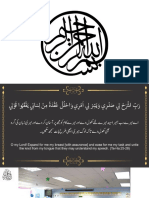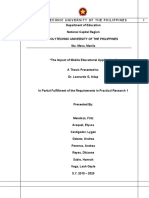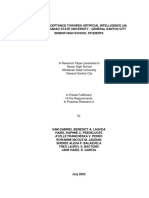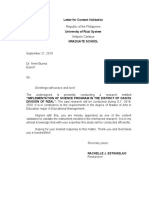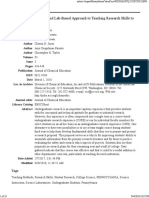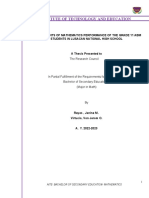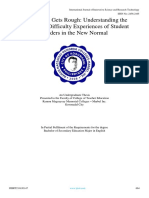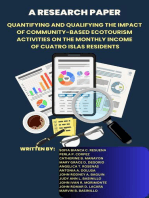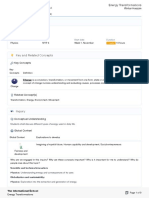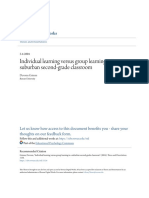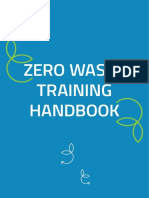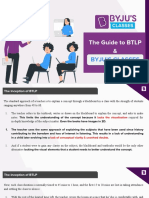Professional Documents
Culture Documents
Challenges Faced by Junior High School Students in The Study of Araling Panlipunan and Its Impactto Their Academic Performance: A Foundation For Intervention Initiatives
Challenges Faced by Junior High School Students in The Study of Araling Panlipunan and Its Impactto Their Academic Performance: A Foundation For Intervention Initiatives
Original Title
Copyright
Available Formats
Share this document
Did you find this document useful?
Is this content inappropriate?
Report this DocumentCopyright:
Available Formats
Challenges Faced by Junior High School Students in The Study of Araling Panlipunan and Its Impactto Their Academic Performance: A Foundation For Intervention Initiatives
Challenges Faced by Junior High School Students in The Study of Araling Panlipunan and Its Impactto Their Academic Performance: A Foundation For Intervention Initiatives
Copyright:
Available Formats
Volume 9, Issue 4, April – 2024 International Journal of Innovative Science and Research Technology
ISSN No:-2456-2165 https://doi.org/10.38124/ijisrt/IJISRT24APR681
COLEGIO DE SANTA RITA DE SAN CARLOS, INC.
AUGUSTINIAN RECOLLECT SISTERS
Challenges Faced by Junior High School
Students in the Study of Araling Panlipunan and its
Impactto their Academic Performance: A
Foundation for Intervention Initiatives
A thesis presented to
The faculty of the Graduate School of Education of
Colegio de SantaRita de San Carlos, Inc.
In Partial Fulfillment
Of the Requirements for the Degree
Master of Arts in Education (MAED) major in Educational Management
Gregorio Joselito C. Baguioro
IJISRT24APR681 www.ijisrt.com 767
Volume 9, Issue 4, April – 2024 International Journal of Innovative Science and Research Technology
ISSN No:-2456-2165 https://doi.org/10.38124/ijisrt/IJISRT24APR681
APPROVAL SHEET
This master′s thesis entitled “CHALLENGES FACED BY JUNIOR HIGH SCHOOL STUDENTS IN THE STUDY OF
ARALING PANLIPUNAN AND ITS IMPACT TO THEIR ACADEMIC PERFORMANCE: A FOUNDATION FOR
INTERVENTION INITIATIVES”, prepared and submitted by GREGORIO JOSELITO C. BAGUIORO, in partial fulfillment
of the requirements for the degree of Master of Arts in Education Major in Educational Management, has been examined and is
recommended for acceptance and approval for the oral examination.
GENEROSA M. NILLAMA, Ed.D.
Adviser
Approved by the Committee of Oral Examination with a grade of_____% on the_____of____________, 2024.
_______________________________
Chairperson
______________________________
Member
Accepted in partial fulfillment of the requirements for the degree of Master of Arts in Education Major in Educational
Management.
SR, CLEOFE MARIA J. AGUA, AR
Dean
IJISRT24APR681 www.ijisrt.com 768
Volume 9, Issue 4, April – 2024 International Journal of Innovative Science and Research Technology
ISSN No:-2456-2165 https://doi.org/10.38124/ijisrt/IJISRT24APR681
ABSTRACT
Education is the foundation upon which people can build better lives, achieve their dreams and aspirations in life and
contribute to society. The Philippine government has recognized the importance of education by enshrining the right to
education. Thus, the Department of Education has implemented many integrated schools in far-flung areas so that
students can have access to education and offer junior high school classes for Grades 7,8,9, and 10.
The study explored the challenges faced by the junior high school students along with their study of Araling
Panlipunan subject and how it can help impact their academic performance, a foundation for intervention initiatives.
This study used the descriptive methodologyto obtain sysMtematic information from a phenomenon, situation, and
population. One hundred (100) participants answered the survey questionnaire. Using the statistical treatment, the result
revealed that the computed r was 0.69 having a moderate correlation between two variables, namely; the challenges faced
by junior high school students in Araling Panlipunan and their academic performance. It was further tested using the z-
test. It resulted to a computed value of 6.87 which is greater than the tabular value of 2.284 thereby rejecting the
hypothesis. It was proven that there is a significant relationship between the two variables.
With the study′s findings, an intervention plan was proposed to help the Junior High School Students overcome the
challenges they faced in the study of Araling Panlipunan and attain their full potential. This will be the basis for the
administrators and teachers in formulating intervention initiatives.
IJISRT24APR681 www.ijisrt.com 769
Volume 9, Issue 4, April – 2024 International Journal of Innovative Science and Research Technology
ISSN No:-2456-2165 https://doi.org/10.38124/ijisrt/IJISRT24APR681
ACKNOWLEDGEMENTS
The completion of this thesis study could not have been possible without the expertise of Dr. Generosa M. Nillama, my
beloved thesis adviser.
The researcher would also like to thank Dr. Rommel Marcellana, Ms. Cybil Ann A. Ramirez, Sr. Cleofe Maria A. Agua,
A.R. and Sr. Teresita Diana, A.R. for sitting on our panel and taking time to read our thesis.
To Mr. Aristotle Abellar, for sharing his knowledge on statistical tools and treatments.
To Dr. Esterline N. Esman, Mr. Elmer L. Salazar, and Mrs. Estrelita M. Sabijon for validating my survey questionnaires, my
appreciation for your inputs.
Last but not the least, to my family, most especially my loving wife Ana Fe, who supported they thesis all the way, without
you none of this is possible.
IJISRT24APR681 www.ijisrt.com 770
Volume 9, Issue 4, April – 2024 International Journal of Innovative Science and Research Technology
ISSN No:-2456-2165 https://doi.org/10.38124/ijisrt/IJISRT24APR681
TABLE OF CONTENTS
TITLE PAGE…………………………………………………………………………………767
APPROVAL SHEET..………….…………………………………………………………….768
ABSTRACT………..…………………………………………………………………………769
ACKNOWLEDGEMENTS….…….……………………………………...……………….....770
TABLE OF CONTENTS……………………………………………………………………..771
CHAPTER I : INTRODUCTION………….……………………………...……………………774
Background of the Study………………………...……………..………..……......…………….774
Related Literature Review………………………………………………..…………...................774
Theoretical Framework…………...…………………………………………..………………….775
Statement of the Problem………………..……………...…………………..……………………776
Statement of Hypothesis…………..…………..…………………………………..……………...777
Significance of the Study……………………………………...………………..…......................777
Scope of the Study………………………………………………………………………………..777
Definition of Terms…………………………………………………………………....................777
CHAPTER II: METHODOLOGY………………………...……………………………………..778
Research Design……………………………………………………………………......................778
Respondents of the Study……………………………………….…………………………………778
Research Instruments……………………………………………………………….......................778
Validation of the Instrument……………………………………….………………………………778
Reliability of the Instrument…………………………….……………………….…………………779
Data Collection Procedure……………………………………………………….….......................779
Statistical Treatment Data……………………………………………………….…………………..779
Ethical Consideration…………………………………………………………….………………….780
CHAPTER III: RESULTS AND DISCUSSION………………………………………….…...........782
Profile of Junior High School Students as to Sex………………………………..………………...…782
CHAPTER IV: SUMMARY OF FINDINGS, CONCLUSION, AND RECOMMENDATION 787
Summary of Findings………………………………………………………………………………….787
Conclusion……..……...………………...…………………………………………………………….788
Recommendation………………………………………………………………………………………788
REFERENCES…………………………………………………………………………………..........789
APPENDICES……………………………………………………………………………..…..……..790
Appendix A: Permission Letter
Appendix B: Survey Questionnaire
Appendix C: Validation of Survey Questionnaire
Appendix D: Statistical Computations
Appendix E. English Editing Certification
Appendix F: Similarity Report (Turnitin)
Curriculum Vitae
IJISRT24APR681 www.ijisrt.com 771
Volume 9, Issue 4, April – 2024 International Journal of Innovative Science and Research Technology
ISSN No:-2456-2165 https://doi.org/10.38124/ijisrt/IJISRT24APR681
LIST OF TABLES
Table 1: Distribution of Research Respondents……..……………………………………. 778
Table 2:Challenges Faced by the Junior High School Students……..…….……………….780
Table 3: Academic Performance of the Junior High School Students…………………….780
Table 4: Profile of Junior High School Students as to Sex……..………………………….782
Table 5: Students′ Interest… …………………………………………...………………….782
Table 6: Instructional Materials and Facilities………………………….………………….783
Table 7: Pedagogical Content and Knowledge of the Subject……………………………..784
Table 8: Level of Academic Performance of the Junior High School
Students in Araling Panlipunan……………………………………………………………784
Table 9: Result of the Test on Relationship between the Challenges Faced By the Junior High School Students in Araling
Panlipunan and their Level of Academic Performance..………………………………………………………..…785
IJISRT24APR681 www.ijisrt.com 772
Volume 9, Issue 4, April – 2024 International Journal of Innovative Science and Research Technology
ISSN No:-2456-2165 https://doi.org/10.38124/ijisrt/IJISRT24APR681
LIST OF FIGURES
Figure 1: Conceptual Framework…………………..………………….……………………. 776
IJISRT24APR681 www.ijisrt.com 773
Volume 9, Issue 4, April – 2024 International Journal of Innovative Science and Research Technology
ISSN No:-2456-2165 https://doi.org/10.38124/ijisrt/IJISRT24APR681
CHAPTER ONE
INTRODUCTION
A. Background of the Study
Education in the Philippines is compulsory. It is the foundation upon which people can build better lives, achieve their
aspirations, and contribute to society. The Philippine government has recognized the importance of education by enshrining the
right to education. K to 12(also known as K-12) is an educational system implemented by the Department of Education that
covers Kindergarten and 12 years of Basic Education (six years of Elementary Education, six years of Secondary Education ) to
provide sufficient time for mastery of concepts and skills, develop life-long learners and prepare graduates for tertiary
education.(DepEd 2023).
Secondary education in the Philippines known as ҅ high school ҆ is divided into two: junior high school and the senior high
school. The junior high school consists of students from grades 7 to 10 while the senior high school consists of students from
grades 11 and 12. The core subjects for junior high school consist of the following: Science, Mathematics, English, Filipino, and
Araling Panlipunan. Other subjects included are MAPEH and TLE. In junior high school, a student is expected to have developed
an outcome-based result on his critical and analytical thinking and also his communication skills at this level which is comparable
to international standards. In the Philippines, the landscape in curricular programs has changed to develop competencies among
students set by globalization, internationalization, regional integration, and the Fourth Industrial Revolution,(Alugar & Itaas,
2021).
Based on global observations and findings, these challenges have already existed long before. Many students in Araling
Panlipunan (Social Studies) lack access to well-equipped schools and lack of qualified teachers to teach the subject and lack of
educational resources.
The national, regional and local levels have common observations regarding the challenges faced by students in the study of
Araling Panlipunan (Social Studies). Among them were language barriers where in most case the subject was taught in Filipino or
Tagalog. It was found to be difficult for non-Filipino or Tagalog-speaking regions. Another challenge was the insufficient
textbooks, reference materials, the presence of technology and the shortage of qualified teachers to teach the subject. All these
challenges could lead to difficulties in understanding and low academic performance (Jabbarov, I., 2023)
Since the implementation of the Junior High School at Handalago Integrated School, the teachers have observed that many
junior high school students have challenges met especially in the study of Araling Panlipunan subject. Consequently,they found
out that if these challenges is not properly addressed, then they may bring undesirable impacts to the learner’s academic
performance.
This study titled “Challenges Faced by the Junior High School Students in the Study of Araling Panlipunan Subject and Its
Impact to Their Academic Performance: A Foundation for Intervention Initiatives”, explores and examine the different challenges
faced by junior high school students in interest on the subject, insufficient instructional materials and facilities, and on
pedagogical content and knowledge of Araling Panlipunan (Social Studies) subject that give impact to their learning outcome.
But still there exists a gap in literature regarding this topic, the lack of comprehensive studies focusing specifically in the
impact of insufficient instructional materialsand facilities on the learning outcomes of the students in Araling Panlipunan. Existing
literature might cover broader aspects of educational challenges but did not delve deeply into the specific effects on inadequate
resources on student performance in this subject. Conducting research in this area could provide valuable insights for educators
and policymakers to address these challenges effectively (Hinton, R., Bronwin, R., & Savage, L.,2019)
This study could provide comprehensive training and professional development opportunities for teachers, identify factors
and challenges contributing to students′ disinterest, to policymakers to address issues on resource allocation and teacher training
programs. This is also a new study conducted to junior high school students specifically in Araling Panlipunan subject. Thus the
above content has motivated the researcher to delve into this study.
B. Related Literature Review
Araling Panlipunan is a subject that aims to teach students about Philippine history, culture, and society. However, students'
learning interest in this subject has been consistently low. Studies have shown that many students find Araling Panlipunan to be a
difficult and uninteresting subject. The National Achievement Test (NAT) results from 2016 to 2018 showed that Araling
Panlipunan had the lowest mean percentage score among all the subjects tested (DepEd, 2018).
IJISRT24APR681 www.ijisrt.com 774
Volume 9, Issue 4, April – 2024 International Journal of Innovative Science and Research Technology
ISSN No:-2456-2165 https://doi.org/10.38124/ijisrt/IJISRT24APR681
Lorbis (2019) reported that the intrinsic value of the subject alone may not be enough to capture students' interest. Their
study showed that while the students had high regard for the importance of Araling Panlipunan, they still found them less
interesting compared to other subjects. The low learning interest in Araling Panlipunan is a significant challenge that needs to be
addressed by educators and policymakers (Lorbis, 2019). The current situation with students’learning interests call for innovative
approaches to teaching and learning that can make the subject matter more engaging and relevant to students.
Derraco and Derraco (2022) found that students perceived Araling Panlipunan as a boring subject due to the use of
traditional teaching methods, such as lectures and textbooks. Students had difficulty understanding the subject matter, which
contributed to their low learning interest. Kelley (2021) also claimed that students found the subject to be uninteresting and
irrelevant to their daily lives. Their study revealed that Araling Panlipunan was the third least-liked subject of elementary pupils,
with only 17.6% expressing a liking for the subject.
Ofiaza (2022) found that teaching methods play a crucial role in shaping students' learning interest in Araling Panlipunan.
His study revealed that students view effective teaching methods help in making students more motivated. Interactive teaching
methods have beenfound to increase students' interest and engagement in the subject. These methods promote active learning and
provide students with opportunities to engage with the subject matter in different ways, enhancing their understanding and
appreciation of the subject (Adipat et al., 2021).
The level of engagement generated by the teacher can also affect students' learning interest in Araling Panlipunan. Boredom
arises when the subject matter is presented in a monotonous and repetitive manner or when the teacher fails to make the lessons
engaging and interesting (Ozerk, 2020). Teachers can address this by incorporating creative and interactive teaching methods,
such as storytelling, multimedia presentations, and other innovative approaches, to enhance students' engagement and interest in
the subject (Abdulrahman et al., 2020). Moreover, the classroom environment is another factor that affects students' interest in
Araling Panlipunan. Students who feel comfortable and safe in their classroom environmenttend to have more positive attitudes
toward learning and higher levels of interest (Usma & Madulili, 2019). Therefore, it is important to create a positive and inclusive
classroom environment that promotes learning and encourages students' participation. Furthermore, various factors can affect
students' interest in Araling Panlipunan. These factors include the teacher's teaching method, students' prior knowledge, and
experiences, relevance of the subject to students' lives and future, and classroom environment. Teachers and educators should
consider these factors when designing and implementing effective instructional strategies and learning materials that promote
students' interest and motivation to learn Araling Panlipunan.
Malalay (2021) cited that Filipinos are used to waiting to be told what to do, reliant on others (leaders and government), and
lacking a sense of urgency. If others have already participated in society’s developmental activities, they will no longer engage.
To support the statement, Hernàndez (2021) cited that people will only participate in what interests them. If not, they will not do
anything. Additionally, Winthrop (2020) noted that there is a link between excellent civic education and higher levels of student
involvement in the 2011 Guardian of Democracy: The Civic Mission of Schools report. Thus, there is a high possibility that the
lack of citizens’ civic participation is attributed to inadequate promotion of civic competence, resulting in a lack of civic
knowledge development among them.
In a study by Reyes (2017), the author mentioned that in Junior High School, only Grade 10 Social Studies directly discussed
civics and civic competency. With that, the rest depends on how the social studies teachers in the lower grades would integrate
civic competency in each topic of grades 7, 8, and 9 Social Studies as it is not directed in terms of its disciplinal nature. Since
promoting civic competence is the aim of Social Studies, this is a problem for teachers of Grades 7, 8, and 9 Araling Panlipunan
because it is written implicitly in the curriculum guide, making them difficult to promote it.
Hamilton et al. (2020) cited that social studies teachers in high school are crucial in helping kids develop the civic
knowledge, abilities, and attitudes they will need to succeed once they graduate.
Thus, this problem motivated the researchers to provide an avenue for the grades 7-9 Araling Panlipunan teachers to discuss
their experiences and challenges in promoting civic competence. Moreover, this study could contribute new knowledge that could
assist fellow Social Studies teachers in understanding further the experiences and challenges of grade 7, 8, and 9 Araling
Panlipunan teachers in promoting civic competence among students.
C. Theoretical Framework
This study was anchored in Student Engagement Theory(SET) which provides a holistic model of the learning process and a
multilinker model of adult development. Student Engagement Theory (Tristan de Frondeville, 2009) was a vital proponent of this
study as it delved into the motivating factors that drive students to actively participate in their education. Understanding the
elements that foster student engagement was pivotal especially, in the context of educational goals and planned target. This
theory provides us the tools to explore how students’ levels of engagement may fluctuate in response to the changing
circumstances, offering valuable insights into optimizing educational experiences.
IJISRT24APR681 www.ijisrt.com 775
Volume 9, Issue 4, April – 2024 International Journal of Innovative Science and Research Technology
ISSN No:-2456-2165 https://doi.org/10.38124/ijisrt/IJISRT24APR681
This theory was highly relevant to this study as it suggests that when students are actively involved, interested, and invested
in their learning, they are more likely to perform better academically. In the context of Araling Panlipunan, engaging students
through interactive lessons, relevant content, and varied teaching strategies can help address challenges such as students′ interest,
learning materials and facilities, and pedagogical content and knowledge, ultimately leading to better academic performance.
Fig 1: Conceptual Framework
Figure 1 presents the process of dealing with the data obtained from the survey questionnaire. As reflected, the study was
pursued by two variables, the independent variable, which is the challenges faced by the junior high school students and the
dependent variable, which is their academic performance. The relationship between the two variables was moderated by sex,
ultimately leading to outputs such as academic performance and intervention activities.
D. Statement of the Problem
This study aimed to find out the extent of the challenges faced by junior high school students in the study of Araling
Panlipunan in Handalago Integrated School, Division of San Carlos City, and its impact to their academic performance for the
second grading period of school year 2023-2024.
Specifically, it Sought to Answer the Following Questions:
What is the demographic profile of the junior high school students in terms of sex?
What is the extent of the challenges faced by junior high school students in the study of Araling Panlipunan subject in
Handalago Integrated School, Division of San Carlos City, Negros Occidental during the school year 2023-2024 on the
following:
Students interest,
Instructional materials and facilities and
Pedagogical Content Knowledge (PCK) of the subject ?
What is the level of academic performance of the junior high school students in Araling Panlipunan subject for the second
grading period of school year 2023-2024?
Is there a significant relationship that exists between the extent of challenges faced by the junior high school students in the
study of Araling Panlipunan and their level of academic performance for the second grading period of school year 2023-2024?
Based on the findings of the study, what intervention initiatives maybe proposed?
IJISRT24APR681 www.ijisrt.com 776
Volume 9, Issue 4, April – 2024 International Journal of Innovative Science and Research Technology
ISSN No:-2456-2165 https://doi.org/10.38124/ijisrt/IJISRT24APR681
E. Statement of Null Hypothesis
There is no significant relationship that exists between the challenges faced by the junior high school students in the study of
Araling Panlipunan and their level of academic performance in Araling Panlipunan for the second grading period of school year
2023-2024.
F. Significance of the Study
The results of the undertaking will provide some insights and benefits that may be useful to the following:
Junior High School Education Supervisors. The results of study may give insights on the education supervisors on the
courses of action they will take to address the identified concerns by providing appropriate technical assistance in the
implementation of the junior high school education in the specific grade level.
Administrators. The findings of the study may provide information regarding the problem encountered by the Junior High
School Students of Handalago Integrated School in the study of Araling Panlipunan.Assuch necessary intervention activities
may be formulated to address said problems and to ensure that teachers could effectively teach the subject.
Araling Panlipunan Teachers. The results may help them re-evaluate in terms of intervention activities and teaching
approaches and contents they used on students.
Students. The results of the study may help them realize and appreciate Araling Panlipunan subject and develop their critical
thinking skills.
Parents. This study may serve as a reference for parents who want to help their children study at home. Being significant
stakeholders, they may also be aware of and actively participate in the educational concerns of their outcomes.
Future Researchers. The findings of the study may be beneficial to the researcher as it may give them deeper understanding
of the problems encountered by the students in the study of Araling Panlipunan.
G. Scope of the Study
This study focusedon determining the challenges faced by Junior High School students in the study of Araling Panlipunan in
Handalago Integrated School, Division of San Carlos City in the school year 2023-2024 and,their academic performance as basis
for intervention activities. It surveyed the profile of 100 students present in the day when the survey was conducted. It also
looked into the challenges encountered in learning Araling Panlipunan in terms of interest of the subject, instructional materials
and facilities, and pedagogical content and knowledge of the subject. Furthermore, the findings of the challenges encountered in
learning the subject is also assessed as a guide in the formulation of recommendations of activities for intervention purposes.
H. Definition of Terms
For a clear understanding of the study, the following terms have been defined conceptually and/or operationally.
Academic Performance. It compasses various factors including grades, test scores, and class participation, reflecting the
effectiveness of the teaching and learning process (Liu, Wang, & Hung,2017). In this study, it is the impact of the challenges
faced by the students.
Challenges.This term has reference to an obstacle, difficulty or, any situation that invites resolution which is recognized as a
contribution toward a known purpose or goal (Merriam Webster Dictionary, 2002 Edition). As used in the study, pertains to
the challenges faced by the junior high school students in terms of student’s interest, instructional materials and facilities, and
pedagogical content knowledge of the Araling Panlipunan subject.
Instructional Materials and Facilities. It is the resources, tools, and aids utilized by educators to facilitate teaching and
enhance student learning experiences within the classroom. These materials can include textbooks, workbooks, worksheets,
audiovisual aids, multimedia presentations, manipulatives, and digital resources among others (Billings & Halstead, 2019). In
this study, it refers to the resources needed to aid teaching and learning.
Pedagogical Content and Knowledge. It refers to the understanding and expertise that teachers possess about the principles
and practices of teaching and learning. It encompasses a range of instructional strategies, classroom management techniques,
assessment methods, and approaches to supporting student learning (Mishra & Koehler, 2006).In this study, it refers to the
strategies, teaching methodologies design to meet the needs of the students.
Relation. A logical or natural association between two or more things ( The American Concise Dictionary, 2000 edition). In
this study, it means the possible connection between the problems encountered by the junior high school students in the study
of Araling Panlipunan subject and their academic performance.
Student’s Interest. Refers to the inclination, curiosity, or enthusiasm that students demonstrate towards particular topics,
subjects, or activities within an educational context. It reflects their intrinsic motivation and engagement with learning
experiences, influencing their level of involvement, attention, and persistence in academic pursuits (Ainley, Hidi & Bernoff,
2002).In this study, it refers to attention given by the students in the study of Araling Panlipunan.
IJISRT24APR681 www.ijisrt.com 777
Volume 9, Issue 4, April – 2024 International Journal of Innovative Science and Research Technology
ISSN No:-2456-2165 https://doi.org/10.38124/ijisrt/IJISRT24APR681
CHAPTER TWO
METHODOLOGY
This chapter introduces the methodology of the study encompassing the research design, respondents of the study, research
instruments, data collection procedures, data analysis techniques, statistical treatment and ethical consideration.
A. Research Design
The descriptive research design was used in this study. It aims to describe characteristics, behaviors, or phenomena as they
naturally occur (Creswell,J.W.,& Creswell, J.D.(2020).
By using this design, narrative inquiry was done first and tackled the key practices in the implementation of educational
concerns. It was particularly well-suited for exploring the educational concerns in Handalago Integrated School. Second, the
quantitative data obtained from the survey questionnaire were tabulated and analyzed. The documentary analysis on the
participants was obtained. The collected data can help on their perceptions, experiences, and attitudes regarding the problems
encountered by the junior high school students in the study of Araling Panlipunan subject in relation to their academic
performance.
The ultimate step in the process entails the integration of the findings derived from the quantitative data of the study. This
integration serves as the cornerstone for the development of a comprehensive learning on the challenges faced by the junior high
school students in Araling Panlipunan in relation to their academic performance to give way for intervention activities by
throughinsights on the data-driven perspectives. This Intervention can be tailored to address help specific needs, challenges, and
opportunities identified.
B. Respondents of the Study
The respondents of the study are the hundred (100) junior high school students of Handalago Integrated School for the
school year 2023-2024. Total Enumeration is used in this research (Garnham et.al 2023).
Table 1: Distribution of Respondents
Grade Level F %
Grade 7 29 29
Grade 8 28 28
Grade 9 20 20
Grade 10 23 23
TOTAL 100 100
Table 1 provided a breakdown of the respondents count for each grade level with twenty-nine(29) junior high school
students representing Grade 7, twenty-seven(28) from Grade 8, twenty(20) from Grade 9, and twenty-three(23) from Grade 10.
The total number of respondents is one hundred(100), thus the total enumeration.
C. Research Instrument
This study used a self-made questionnaire to gather data on the challenges faced by junior high school students in the study
of Araling Panlipunan subject. This questionnaire was in a checklist form having 30 items grouped into10 items for each of the
three (3) challenges which were students′ interest, instructional materials and facilities, and pedagogical content and knowledge of
the subject.
The questionnaire consisted of both closed-ended and Likert-scale with the descriptions and indicators, 5=Strongly Agree,
4=Agree, 3,=Undecided, 2=Disagree,1=Strongly Disagree designed to gather quantitative data on student’s interest, instructional
materials and facilities, and pedagogical content and knowledge.
Documentary analysis on academic records for the second grading period in Araling Panlipunan subject provides objective
about the student’s educational performance and achievement. These were copied from their report card (DepEd Form 138-E)
provided by their respective advisers.
D. Validation of the Research Instrument
To measure and produce data that are true and accurate (Laerd,2022), the instrument passed through validation with three
experts on the subject. These experts carefully examined each item on the survey questionnaire.
IJISRT24APR681 www.ijisrt.com 778
Volume 9, Issue 4, April – 2024 International Journal of Innovative Science and Research Technology
ISSN No:-2456-2165 https://doi.org/10.38124/ijisrt/IJISRT24APR681
Content Validity Ratio:
CVR = Ne – (N/2) / N/2
= 3 –( 3/2)/ 3/2
= 3- 1.5 / 1.5
= 1.5 / 1.5
CVR = 1.0
E. Reliability of the Instrument
To determine the reliability of the questionnaires, the researcher conducted a dry run. The result was determined through the
use of Cronbach′s Alpha formula:
a=k/ k – 1 (S²y – ƩSi² / Sy²)
The computation result was 0.86 which was interpreted as good, so the items were clear and reliable hence no revision was
done.
F. Data Collection Procedure
Upon the approval of the thesis proposal, the researcher reproduced several copies of the survey questionnaire, circulated and
filled in by the subject-respondents with prior consent from the School Head and the Schools Division Superintendent of the
Division of San Carlos City.
Before the administration, the questionnaire underwent rigorous validation procedures, including expert review and pilot
testing to ensure its validity and reliability. The researcher also asked permission from the respondents and their parents to
conduct data gathering.
To ensure the reliability of the instrument, the researcher personally administered the questionnaire to the subject-
respondents and thoroughly explained how this research would be of value to the concerned students and to the organization in
general.
G. Statistical Treatment of Data
The data to be gathered from the research were processed using the following statistical tools:
For research question number 1, on the profiling as to sex of the junior high school students, the statistical treatment to be
used was the percentage.
Percentage:
% = f / nx 100
Where:
% = percentage
f = frequency
n= number of cases
For research questions 2 and 3, “ What is the extent of the challenges faced by the junior high school students in the study of
Araling Panlipunan subject in Handalago Integrated School?” and “ What is the level of academic performance of these students
for the second grading period of school year 2023-2024?”
Weighted Mean
The results was analyzed following the formula.
Weighted Mean
WX̅= S1(W5)+S2(W4)+S3(W3)+S4(W2)+S5(W1)
N
Where:
S= responses
N= number of cases
W= weight assigned to the scale
WX̅ = weighted mean
To interpret the weighted mean value, the following arbitrary tables was used as references.
IJISRT24APR681 www.ijisrt.com 779
Volume 9, Issue 4, April – 2024 International Journal of Innovative Science and Research Technology
ISSN No:-2456-2165 https://doi.org/10.38124/ijisrt/IJISRT24APR681
Table 2: Challenges Faced of the Junior High School Students
Scale Hypothetical Mean Range Interpretation
5 4.20 – 5.00 Strongly Agree
4 3.40 – 4.19 Agree
3 2.60 – 3.39 Undecided
2 1.80 – 2.59 Disagree
1 1.00 – 1.79 Strongly disagree
Table 3: Academic Performance of the Junior High School Students
Scale Mean Score Percentage Academic Numerical Rating Description
5 4.20 – 5.00 90 – 100 Outstanding
4 3.40 – 4.19 85 – 89 Very Satisfactory
3 2.60 – 3.39 80 – 84 Satisfactory
2 1.80 – 2.59 75 – 79 Fairly Satisfactory
1 1.00 – 1.79 Below 75 Did not meet expectation
For research question number 4 on the significant relationship between problems encountered by the junior high school
students in relation to their academic performance, the Pearson Product Moment Correlation Coefficient ( Pearson r ) and Z-test
were used with the formula:
Pearson r:
r = Pearson r
n= total number of population
Ʃx = Summation of x or variable x
Ʃy = Summation of y or variable y
Ʃxy = Summation of x and y or variable x and y
Ʃx^2=Summation of squared variable x
Ʃy^2 = Summation of squared variable y
To test the significance of r which will become the basis for accepting or rejecting the hypothesis, the Z- test was used with
this formula.
Where:
z= z – test
rxy = Pearson Product Moment
n= number of pair in computing rxy
1 = constant
H. Ethical Consideration
This paper will be submitted to Colegio de Santa Rita de San Carlos, Inc. Graduate School to be assessed as required by the
institution.
To establish transparency and trustworthiness in the conduct of the study, ethical practices will be observed and considered.
Prior to the implementation of the data gathering, the researcher will secure permission from the immediate superiors and the
Assistant Schools Division Superintendent and Principal of the school of the Division of San Carlos City, Negros Occidental,
informing them of the data gathered which are needed in the study.
IJISRT24APR681 www.ijisrt.com 780
Volume 9, Issue 4, April – 2024 International Journal of Innovative Science and Research Technology
ISSN No:-2456-2165 https://doi.org/10.38124/ijisrt/IJISRT24APR681
The participants will be informed of the purpose, procedure, potential risks, and benefits of the study. In addition, they will
be informed that their participation is voluntary and can withdraw anytime without adverse consequences. Furthermore, their
identities will be confidential.
The data gathered will also be held confidential. They must be securely archived or must be deleted using the “delete”
command or drag items to the “trash” folder.
IJISRT24APR681 www.ijisrt.com 781
Volume 9, Issue 4, April – 2024 International Journal of Innovative Science and Research Technology
ISSN No:-2456-2165 https://doi.org/10.38124/ijisrt/IJISRT24APR681
CHAPTER THREE
RESULTS AND DISCUSSION
This chapter presents the results, analysis and discussion of the study′s findings.
A. Statement of the Problem
Problem 1: Profile of Junior High School Students as to Sex
Table 4: Profile of Students by Sex
Table 4 presents survey responses related to the demographic profile on sex of the respondents. Out of 100 participants, 77
or 76.25 were males, while 23 or 23.75 were females.This showed that majority of the junior high school students of Handalago
Integrated School, Division of San Carlos City were males. This indicates a significant gender disparity, with much higher
representation of males compared to females. Such a distribution might suggest potential gender-related trends or disparities
within the student population being surveyed. Cultural influences and access to education maybe considered as factors of this
ratio.
Table 5: Students′Interest
N=100
IJISRT24APR681 www.ijisrt.com 782
Volume 9, Issue 4, April – 2024 International Journal of Innovative Science and Research Technology
ISSN No:-2456-2165 https://doi.org/10.38124/ijisrt/IJISRT24APR681
Findings presented that students′ had shown strong agreement in indicators 1,2,3,& 4 in the interest with the subject while in
indicators 6,7,8,9, and 10, students were undecided. The overall weighted mean score of 3.36, described as undecided implies that
there is a need for teachers to integrate interactive teaching methods, and personalized approaches to enhance engagement and
motivation of students. An intrinsic value of the subject alone may not be enough to capture students′ interest (Lorbis 2019).
Table 6: Instructional Materials and Facilities
N= 100
Table 6 presented survey findings that students showed strong agreement in indicators 1 & 2 while in indicator′s 3 to 9,
students were undecided. They disagree on indicator 10. The overall weighted mean was 3.04, shows that the students were
undecided on the challenges they faced as to instructional materials and facilities.This implied that the students needed to access
quality instructional materials and facilities. Basic amenities like clean water, electricity, comfort rooms.Teachers can address this
by incorporating creative and interactive methods such as story-telling, multimedia presentations, and other innovative approaches
to enhance students′ engagement and interest in the subject (Abdulrahman et al., 2020).
IJISRT24APR681 www.ijisrt.com 783
Volume 9, Issue 4, April – 2024 International Journal of Innovative Science and Research Technology
ISSN No:-2456-2165 https://doi.org/10.38124/ijisrt/IJISRT24APR681
Table 7: Pedagogical Content and Knowledge of the Subject
N=100
Table 7 presents the participants′ information on the pedagogical content and knowledge of Araling Panlipunan subject. In
question 2.3, the weighted mean scores of aspects 1, 3, and 5 were 3.40 and 3. 56, which indicated agreement on knowledge to
apply their practical experiences in the lesson, doing the assignments individually, and never experiencedoing/ working on
projects in groups. Majority of the respondents were undecided on the level of knowledge of the challenges met and experience.
The weighted mean score fall in between 2.60 – 3.39. The overall weighted mean score of 3.17, suggested undecided.Teaching
methods play a crucial role in shaping students′ learning interest in Araling Panlipunan (Ofiaza, 2022).
Table 8: Level of Academic Performance of the Junior High School Students in Araling Panlipunan
N= 100
SCALE ACADEMIC NUMERICAL RATING f % Wx̅ I
5 90-100 10 10
4 85-89 35 35 3.28 Satisfactory
3 80-84 28 28
2 76-79 27 27
1 Below 75 0 0
The findings of Table 8, revealed that the academic performance of the junior high school students got a weighted mean of
3.28 with a verbal description of satisfactory. The result indicated average intellectual capabilities among the respondents in the
Araling Panlipunan. This showed that there is still a need to improve the students′ performance through nurturing or improving
their learning environment which may include teaching skills and practices in using instructional materials.
IJISRT24APR681 www.ijisrt.com 784
Volume 9, Issue 4, April – 2024 International Journal of Innovative Science and Research Technology
ISSN No:-2456-2165 https://doi.org/10.38124/ijisrt/IJISRT24APR681
Table 9: Result of the Test on Relationship Between the Challenges Faced by the Junior High School Students in Araling
Panlipunan and their Level of Academic Performance
Z-test
HO rxy I Computed Vakue Tabular Value Decision Remarks
Extent of the Challenges
Faced by Jumior High
Students in the of
Araling Panlipunan and 0.69 Moderately 6.87 2.284 Reject HO Significant
their Level O Academic Correlated
Performance for the
second grading period
os school year 2023-2024
As presented on Table 9, the relationship between the extent of challenges faced by junior high school students in Araling
Panlipunan and their level of academic performance pointed out that the computed r gave a result of 0.69 which means that there
was a moderate correlation between the two variables.
The data showed there was a significant relationship that exists between the challenges faced by junior high school students
and their academic performance. This was proven in the z-test result in which the computed value is 6.87 which was greater than
the tabular value of 2.284, hence the rejection of the hypothesis. This further indicated that there was a significant relationship
between the two variables.
IJISRT24APR681 www.ijisrt.com 785
Volume 9, Issue 4, April – 2024 International Journal of Innovative Science and Research Technology
ISSN No:-2456-2165 https://doi.org/10.38124/ijisrt/IJISRT24APR681
CHAPTER FOUR
SUMMARY OF FINDINGS, CONCLUSION AND RECOMMENDATION
After all the data were analyzed under the light of the problems and the hypothesis, the findings of the study were herein
summarized, and conclusions and pertinent recommendations were given.
A. Summary of Findings
The study “ Challenges Faced by the Junior High School Students in the Study of Araling Panlipunan and Its Impact on
Their Academic Performance: A Foundation for Intervention Initiatives” uses the descriptive methodology.It aims to describe
characteristics, behaviors, or phenomena as they naturally occur (Creswell,J.W.,& Creswell, J.D.(2020).
The respondents of the study were the (100) one hundred junior high school students of Handalago Integrated School during
the school year 2023-2024. The research included four questions uncovering relationships between the challenges faced by the
junior high school students in Araling Panlipunan and their academic performance examining the different perception of the
students and developing an intervention initiatives to increase academic performance and improve practice of students.
Demographic profile of the junior high school students in terms of sex
Based on the research findings, the majority of the one hundred (100) participants were male having 77 or 76.25 percent
while the rest of the participants were female at 23 or 23.75 percent.
Students′ of Interest
Based on survey results, students agreed to statements 1 to 4 with a weighted mean between 3.40- 4.19 but were undecided
to statements 5 to 10 with a weighted mean of 2.60- 3.39. The weighted mean of 3.36 implies that many of the of the students
were still undecided in terms of the challenges faced on the students′ interest in the Araling Panlipunan subject.
Instructional Materials and Facilities
On the first two statements, the participants showed agreement with weighted mean score of 3.68 and 3.44. This means that
the participants felt the need for these facilities. Most of the participants answered they are undecided on statements 3 to 9. They
lightly need these materials but somehow they were still considered as their challenges in the study of the subject. The participants
disagreed in 10th statement as to the unavailability ofwater and CR facilities in school, somehow it does not affect them. The
overall weighted mean score was 3.04 indicated that students were still undecided in the challenges they faced on instructional
materials and facilities.
Pedagogical Content and Knowledge of the Subject
Based on the survey findings presented, the participants showed agreement on statements 1, 3, and 5 with a weighted mean
score of 3.40, 3.40, and 3.56. This proved that the participants had a great need in these aspects in pedagogical content and
knowledge of the subject. There was a need for them to apply their practical experience, work in groups especially making
projects and answering assignments. Majority of the participants answeredthat they were undecided on many challenges posed to
them. Their weighted mean scores fall between 2.60-3.39. The overall weighted mean score in all aspects was 3.17 which was
interpreted that many of the respondents were still undecided as to the challenges they faced on the pedagogical content and
knowledge of the subject.
Level of Academic Performance
On the level of academic performance of the junior high school students in Araling Panlipunan subject for the second
grading period of school year 2023-2024. Table 8 reveals that the academic performance of the students got a weighted mean of
3.28 with a verbal description of satisfactory. The result indicated average intellectual capabilities among the respondents in the
Araling Panlipunan, thus there is still a need to improve it.
Significance between the challenges faced by Junior High School Students in the study of Araling Panlipunan and their Level
of Academic Performance
As to the significant relation between the challenges faced by the junior high school students in the study of Araling
Panlipunan and their Level of academic performance for the second grading of the school year 2023-2024, as shown in Table 9,
there was a significantrelationshipthat existsbetween the two variables as indicated in the z-test result computed value of 6.87
which was greater thanthe tabular value of 2.284 prescribed to be significant hence the hypothesis was rejected.
Proposed intervention initiatives were conceptualized and formulated based on the findings of the study. These activities are
important to facilitate and enhance teaching-learning conditions and help improve the academic progress of the students. The
activities are focused on the socio-emotional development of the students, teacher training, curriculum enhancement, student
support, stake-holders communication, and the sustainability of the activities.
IJISRT24APR681 www.ijisrt.com 786
Volume 9, Issue 4, April – 2024 International Journal of Innovative Science and Research Technology
ISSN No:-2456-2165 https://doi.org/10.38124/ijisrt/IJISRT24APR681
B. Conclusion
The junior high school students of Handalago Integrated School encountered multifaceted challenges in the study of Araling
Panlipunan, spanning from waning interest and limited instructional materials to inadequate facilities and potential gaps
pedagogical knowledge and content delivery. These hurdles collectively contribute a discernible impact on their academic
performance emphasizing the need for comprehensive solutions and targeted interventions to foster a more conducive learning
environment in this crucial subject.
C. Recommendation
Based on the conclusions drawn from the findingsof the study, Challenges Faced by Junior High School Students in the
Study of Araling Panlipunan and its Impact to their Academic Performance: A Foundation for Intervention Initiatives. The
following recommendations maybe offered and considered:
Administrators.Administrators may implement programs that may help enhance student engagement such as extracurricular
activities, interactive learning approaches,(through cellphones), and mentorship programs to foster a sense of belonging and
interest in learning. He may find ways to fund the resources, like the adopt aschool program, to provide necessary materials
and facilities for the school. Regularly assess in the effectiveness of the interventions.
Araling Panlipunan Teachers.Continuous professional developmentshould be encouraged among teachers to keep them
abreast on educational initiatives especially
on teaching strategies and techniques in order to enhance student’s learning. They must build a positive relation with students
to deliver the instructions effectively.
Junior High School Education Supervisors.They can regularly review, and update the curriculum to ensure it is relevant,
engaging and aligned with the student’s interest.
Parents. Maintain open and regular communication with the teachers, Hand in hand, parents their children′s academic
challenges and assist their children. Establish a supportive home environment where children can expressed their feelings,
specifically concerning their academic struggles.
IJISRT24APR681 www.ijisrt.com 787
Volume 9, Issue 4, April – 2024 International Journal of Innovative Science and Research Technology
ISSN No:-2456-2165 https://doi.org/10.38124/ijisrt/IJISRT24APR681
REFERENCES
[1]. Abdulrahman, M. D., Faruk, N., Oloyede, A. A., Surajudeen-Bakinde, N.T., Olawoyin, L.A.,Mejabi, O. V., ... & Azeez, A.
L. (2020). Multimedia tools in the teaching and learning processes: A systematic review. Heliyon (Londen), 6(11).eo512.
https://doi.org/10.1016/j.heliyon.2020.eo532.
[2]. Adipat, S., Laksana, K., Busayanon, K., Asawasowan, A., & Adipat, B. (2021). Engaging students in the learning process
with game-based learning: The fundamental concepts. International Journal of Technology in Education (IJTE), 4(3), 542-
552https://doi.org/10.46328/ijte.169
[3]. Ainley, M., Hidi, S., & Berndorff, D. ( 2002). Interest, learning, and the psychological processes that mediate their
relationship. Journal of Educational Psychology, 94(3), 545-561 https://doi.org/10.1037/0022-0663.94.3.545
[4]. Alugar, R.B & Itaas. E.C.(2021). Exploring the implementatioin of Curriculum Quality Await inPhilippine State
University, International Journal, Curriculum and Instruction 13(1),1-16 doc: 10.369410010.year_2021
[5]. Billings, D.M., & Halsted, J.A. (2019). Teaching in nursing: A guide for faculty (6th ed.) Elsevier.Creswell, J.W., &
Creswell, J.D.(2020). Research design: Qualitative, quantitative, and mixed Methods approaches(5th ed.)
[6]. Derraco, M.C., & Derraco, N. (2022). Relations of Learners’ Attitude and Academic Performance in Online Distance
Learning In Araling Panlipunan. InternationalJournal of Multidisciplinary Research and Analysis.
[7]. Hamilton, L., Kaufman, J., & Hu, L. (2020). Social Studies Teachers’ Perspectives on Key CivicOutcomes in 2010 and
2019. Civic Development in the Era of TrutIn RAND Corporation eBooks. https://doi.org/10.7249/rra112-4
[8]. Hernandez, C. (2020). The role of citizens in smart cities and urban infrastructures. Separation of citizen participation
topics (1st ed., Vol. 10). Elsevier Inc.https://doi.org/10.1016/C2018-0-00326-6
[9]. Kelley, C. (2021). “Social Studies is Boring”: The Role of Student Attitude and Achievement inthe Middle School Social
Studies Classroom (Doctoral dissertation, OhioDominican University).
[10]. Liu, X., Wang, J., & Huang, M (2017). Academic Performance Prediction for Freshman: A Case Study of Web Mining in
Chinese University. IEEE Access, 5, 15014-15023.
[11]. Lorbis, J. C. C. (2019). Utilization of Contextualized Teaching and Learning (CTL) Approach in Grade Two Araling
Panlipunan. Online Submission.
[12]. Malalay, R. (2021). The Strengths and Weaknesses of The Filipino Character: A Socio Cultural Issue. Scribd.
https://www.scribd.com/document/524169391/437995799
[13]. Mishra, P., & Koehler, M.J.(2006). Technological Pedagogical Content Knowledge: A Framework for Teacher
Knowledge. Teachers College Record, 108(6) 1017-1054
[14]. Ofiaza, E. S. (2023). The Effect of Teacher’s Teaching Style in Araling Panlipunan on Student’s Motivation of Grade 8
Students in Sta. Cruz South High School. International Journal of Multidisciplinary: Applied Business and Education
Research, 4(3), 845-852. https://doi.org/10.11594/ijmaber.04.03.17
[15]. Özerk, G. (2020). Academic Boredom: An Underestimated Challenge in Schools. International electronic journal of
elementary education, 13(1), 117-125. https://doi.org/10.26822/iejee.2020.177
[16]. Reyes, N. M. A. (2017). Civic Competency in Junior High School - Mapping through The Content and Performance
Standards of the Philippine Social Studies (Araling Panlipunan) Curriculum. 2nd Asian Education
Symposium.https://doi.org/10.5220/0007306304670472
[17]. Rodriguez, Jonathan M. “ Students Learning Practice And Academic Achievemnet In Technology and Livelihood
Education (TLE) Of Vallehermoso District: Basis For A Proposed Intervention Plan, Unpublished Master′s Thesis, Colegio
de SantaRita, San Carlos City, Negros Occidental, (March 2013).
[18]. Usman, Y. D., & Madudili, C. G. (2019). Evaluation of the Effect of Learning Environment on Students' Academic
Performance in Nigeria. Online Submission.
[19]. Winthrop, R. (2020). The need for civic education in 21st-century schools. Bookings.
https://www.brookings.edu/articles/the-need-for-civic-education-in-21st-century-schools
IJISRT24APR681 www.ijisrt.com 788
Volume 9, Issue 4, April – 2024 International Journal of Innovative Science and Research Technology
ISSN No:-2456-2165 https://doi.org/10.38124/ijisrt/IJISRT24APR681
APPENDICES
APPENDIX A
Letter of Permission to the Schools Division Superintendent
IJISRT24APR681 www.ijisrt.com 789
Volume 9, Issue 4, April – 2024 International Journal of Innovative Science and Research Technology
ISSN No:-2456-2165 https://doi.org/10.38124/ijisrt/IJISRT24APR681
Letter of Permission to School Head
IJISRT24APR681 www.ijisrt.com 790
Volume 9, Issue 4, April – 2024 International Journal of Innovative Science and Research Technology
ISSN No:-2456-2165 https://doi.org/10.38124/ijisrt/IJISRT24APR681
ASSENT FORM
IJISRT24APR681 www.ijisrt.com 791
Volume 9, Issue 4, April – 2024 International Journal of Innovative Science and Research Technology
ISSN No:-2456-2165 https://doi.org/10.38124/ijisrt/IJISRT24APR681
APPENDIX B
QUESTIONNAIRE
Challenges Faced by Junior High School Students in the Study of Araling Panlipunan and its
Impact to their Academic Performance: A Basis For Intervention Initiatives
A. Part I. Personal Information
Please provide the needed information accurately.
Name: (Optional)
School:
Year Level:
B. Part II. Challenges Aced by Junior High School Students
Directions: Here are some challenges which you might have experienced or experiencing high school student. Please check
(/) the column that corresponds to your best perception on the challenge/ situation. Please be guided by the following scaling
description:
5 – Strongly Agree (SA)
4 – Agree(A)
3 – Undecided(U)
2 – Disagree(D)
1 – Strongly disagree(SD)
C. Students’ Interest
Items Challenges SA A U D SD
5 4 3 2 1
1 I feel passive in class recitation
2 I dislike participating in class discussion
3 I am poorly aware of the goals, purposes and objectives of the junior
high school
4 I have insufficient knowledge of the rationale why junior high school is
implemented
5 I am enable to relate my personal experiences for long retention in
learning
6 I feel uncomfortable working my assignments Alone
7 I am unable to use learning material effectively
8 I dislike making projects on time
9 I cannot easily adjust to the new ways of lesson
Presentation
10 I am unable to meet the standard of the performance assessment
D. Instructional Materials and Facilities
Items Challenges SA A U D SD
5 4 3 2 1
1 Unavailability of computers in school
2 No projector and other related ICT materials that will aid students learning
3 Lack of textbook and other reference materials in Araling Panlipunan
4 Inadequate resources from the community to help student learning
5 No school library for students to access on reading materials
6 No available materials to use for students’ projects
7 No resource reading materials available to be used for research works
8 Modules are not given on time
9 No resource person to talk on specific topic
10 No water and CR facilities in the school
IJISRT24APR681 www.ijisrt.com 792
Volume 9, Issue 4, April – 2024 International Journal of Innovative Science and Research Technology
ISSN No:-2456-2165 https://doi.org/10.38124/ijisrt/IJISRT24APR681
E. Pedagogical Content and Knowledge of the Subject
Items Challenges SA A U D SD
5 4 3 2 1
As a student…
1 … I cannot apply my practical experiences to the lesson
2 … I have no appropriate technology – assisted instruction before
3 … Assignments are mostly done individually
4 … I cannot learn more due to inappropriate strategies and techniques
5 … I never experience doing/ working on projects with my classmates in groups
6 Assessment tools to rate students’ performance are not widely used
7 Unavailability of community resources to be used
8 No team teaching is practiced to bring about effective teaching
9 No qualified resource person to be tapped as resource speaker
10 No available person to share his expertise on the subject matter
IJISRT24APR681 www.ijisrt.com 793
Volume 9, Issue 4, April – 2024 International Journal of Innovative Science and Research Technology
ISSN No:-2456-2165 https://doi.org/10.38124/ijisrt/IJISRT24APR681
APPENDIX C
VALIDATION SHEET FOR SURVEY QUESTIONNAIRE
IJISRT24APR681 www.ijisrt.com 794
Volume 9, Issue 4, April – 2024 International Journal of Innovative Science and Research Technology
ISSN No:-2456-2165 https://doi.org/10.38124/ijisrt/IJISRT24APR681
IJISRT24APR681 www.ijisrt.com 795
Volume 9, Issue 4, April – 2024 International Journal of Innovative Science and Research Technology
ISSN No:-2456-2165 https://doi.org/10.38124/ijisrt/IJISRT24APR681
IJISRT24APR681 www.ijisrt.com 796
Volume 9, Issue 4, April – 2024 International Journal of Innovative Science and Research Technology
ISSN No:-2456-2165 https://doi.org/10.38124/ijisrt/IJISRT24APR681
APPENDIX D
STATISTICAL COMPUTATIONS
Sample Computation in Finding the Percentage
% = f / N x 100
= 10 / 100 x 100
= 0.10 x 100
% = 10
Sample Computation on finding the weighted mean
SCALE ACADEMIC NUMERICAL RATING f % Wx̅ I
5 90-100 10 10
4 85-89 35 35 3.28 Satisfactory
3 80-84 28 28
2 76-79 27 27
1 Below 75 0 0
Wx̅ =S1(W1)+ S2(W2) + S3(W3) + S4(W4)+ S5(W)
N
=10(5)+35(4)+28(3)+27(2)+0(1)
100
= 50 +140+84+54+0
100
= 328
100
Wx̅
= 3.28
IJISRT24APR681 www.ijisrt.com 797
Volume 9, Issue 4, April – 2024 International Journal of Innovative Science and Research Technology
ISSN No:-2456-2165 https://doi.org/10.38124/ijisrt/IJISRT24APR681
APPENDIX E
IJISRT24APR681 www.ijisrt.com 798
Volume 9, Issue 4, April – 2024 International Journal of Innovative Science and Research Technology
ISSN No:-2456-2165 https://doi.org/10.38124/ijisrt/IJISRT24APR681
APPENDIX F
SIMILARITY REPORT (TURNITIN)
IJISRT24APR681 www.ijisrt.com 799
You might also like
- Creating Engaging Lesson PlansDocument33 pagesCreating Engaging Lesson Plansqazi1975No ratings yet
- THESISFINALVillanuevaand Banzal 2Document62 pagesTHESISFINALVillanuevaand Banzal 2Johncel Palomata BuezaNo ratings yet
- Academic Performance of Grade 10-A Class in Mathematics and Science From 1st-3rd Quarter For The S.Y. 2017-2018Document23 pagesAcademic Performance of Grade 10-A Class in Mathematics and Science From 1st-3rd Quarter For The S.Y. 2017-2018Abraham Philip Parena40% (5)
- The Impact of Mobile Educational ApplicationsDocument165 pagesThe Impact of Mobile Educational ApplicationsMendoza Fritz0% (1)
- JJIGSAWDocument60 pagesJJIGSAWJOHNERROL CARCELLARNo ratings yet
- Tangina JpeggggDocument58 pagesTangina JpeggggReigh LibrandaNo ratings yet
- Approaches To School CurriculumDocument13 pagesApproaches To School CurriculumRoselyn Dacillo92% (12)
- Psy 210.full NotesDocument56 pagesPsy 210.full NotesDebrah moigeNo ratings yet
- Thesis Final 2Document57 pagesThesis Final 2Kister Quin EscanillaNo ratings yet
- Socio-Cultural Perspectives On Cancel Culture (Full Manuscript)Document149 pagesSocio-Cultural Perspectives On Cancel Culture (Full Manuscript)Jesusa100% (1)
- GURO21 Course1 Module 2Document235 pagesGURO21 Course1 Module 2Dexter Jimenez Resullar0% (1)
- Edfd462 Assignment 1 FinalDocument20 pagesEdfd462 Assignment 1 Finalapi-239589333No ratings yet
- The Schoolwide Enrichment Model in Science: A Hands-On Approach for Engaging Young ScientistsFrom EverandThe Schoolwide Enrichment Model in Science: A Hands-On Approach for Engaging Young ScientistsRating: 5 out of 5 stars5/5 (1)
- Module 2 The Teaching ProfessionDocument37 pagesModule 2 The Teaching ProfessionTaal Mia100% (2)
- Visual Art Lesson Plan For Integrating Arts 4000Document9 pagesVisual Art Lesson Plan For Integrating Arts 4000api-122605596No ratings yet
- Hassle and Tussle: The Challenges of Teachers in Carmen National High SchoolDocument33 pagesHassle and Tussle: The Challenges of Teachers in Carmen National High SchoolInternational Journal of Innovative Science and Research TechnologyNo ratings yet
- Through The Lens of Struggle: An Inquiry Into The Reading Difficulties of Secondary High School LearnersDocument59 pagesThrough The Lens of Struggle: An Inquiry Into The Reading Difficulties of Secondary High School LearnersInternational Journal of Innovative Science and Research TechnologyNo ratings yet
- Managing The Implementation of The Senior High School Alternative Learning System (ALS) Program: Perspective of Mobile TeachersDocument77 pagesManaging The Implementation of The Senior High School Alternative Learning System (ALS) Program: Perspective of Mobile TeachersInternational Journal of Innovative Science and Research TechnologyNo ratings yet
- Teacher Tales: Navigating The Complex Landscape of Multiple Tasks in An Elementary SchoolDocument59 pagesTeacher Tales: Navigating The Complex Landscape of Multiple Tasks in An Elementary SchoolInternational Journal of Innovative Science and Research TechnologyNo ratings yet
- Philippine Normal University Visayas: The National Center For Teacher EducationDocument107 pagesPhilippine Normal University Visayas: The National Center For Teacher EducationShiela Mae Regalado CabiaoNo ratings yet
- 2 perceptionsTVL BP - PreliminariesDocument8 pages2 perceptionsTVL BP - PreliminariesedjaylacayaNo ratings yet
- Expo Paper GRP 2Document39 pagesExpo Paper GRP 2buenoradlouisNo ratings yet
- A Study Planner App: Helping Students Stay Organized and On-TrackDocument34 pagesA Study Planner App: Helping Students Stay Organized and On-TrackJohn Paul SingcoNo ratings yet
- Examining The Relationship Between Socioeconomic Factors and Academic Outcomes of Senior High School Students at CDMDocument57 pagesExamining The Relationship Between Socioeconomic Factors and Academic Outcomes of Senior High School Students at CDMaccismus36No ratings yet
- Fredeluces Et Al. 2023. Level of Acceptance Towards AI in MSU SHSDocument124 pagesFredeluces Et Al. 2023. Level of Acceptance Towards AI in MSU SHSElijah LedesmaNo ratings yet
- The Learning Styles of Grade 12 Stem Students Amidst The Global PandemicDocument84 pagesThe Learning Styles of Grade 12 Stem Students Amidst The Global PandemicSheina Mae TacazonNo ratings yet
- Impact of Work Immersion To CSS Students Research in IIIDocument45 pagesImpact of Work Immersion To CSS Students Research in IIIRicardo JoserNo ratings yet
- Thesis Paper Chapter 1 5 Super Final Final 231023 095655Document126 pagesThesis Paper Chapter 1 5 Super Final Final 231023 095655Via Divina Celina ParpanNo ratings yet
- Final Research - Group6Document68 pagesFinal Research - Group6Kent MoriNo ratings yet
- Effects of Science Process Skills Approach On Academic Performance and Attitude of Integrated Science Students With Varied Abilities.Document225 pagesEffects of Science Process Skills Approach On Academic Performance and Attitude of Integrated Science Students With Varied Abilities.abu_faysel100% (5)
- Vol 15 No 4 - Special IssueDocument124 pagesVol 15 No 4 - Special Issueijlter.orgNo ratings yet
- Eastern Tayabas College, IncDocument50 pagesEastern Tayabas College, IncJulian LacquinNo ratings yet
- Research 2014Document30 pagesResearch 2014sosina eseyewNo ratings yet
- Group 1 STEM Chapter 1 5 Final ManuscriptDocument62 pagesGroup 1 STEM Chapter 1 5 Final Manuscripteli.ruiz.shslcsinhsNo ratings yet
- Socio-Cultural Perspectives On Cancel Culture (Full Manuscript)Document135 pagesSocio-Cultural Perspectives On Cancel Culture (Full Manuscript)JesusaNo ratings yet
- The Experiences of Non-PE Teachers in Teaching First Aid and Emergency Response: A Phenomenological StudyDocument89 pagesThe Experiences of Non-PE Teachers in Teaching First Aid and Emergency Response: A Phenomenological StudyInternational Journal of Innovative Science and Research TechnologyNo ratings yet
- The Experiences of Non-PE Teachers in Teaching First Aid and Emergency Response: A Phenomenological StudyDocument89 pagesThe Experiences of Non-PE Teachers in Teaching First Aid and Emergency Response: A Phenomenological StudyInternational Journal of Innovative Science and Research TechnologyNo ratings yet
- Beneficial Factors of Giving Free Condom Among Senior Highschool Students in Gateway Integrated School of Science and TechnologyDocument14 pagesBeneficial Factors of Giving Free Condom Among Senior Highschool Students in Gateway Integrated School of Science and TechnologyJewel VisitacionNo ratings yet
- Preliminaries For Hardbind 1Document12 pagesPreliminaries For Hardbind 1villancioprincess75No ratings yet
- Effects of Identified Information and Communications Technology Devices in Teaching and Learning MathematicsDocument7 pagesEffects of Identified Information and Communications Technology Devices in Teaching and Learning MathematicsJezelyn Cortez FabeliniaNo ratings yet
- Perspective of Student Interms of JobDocument65 pagesPerspective of Student Interms of JobJo FrondaNo ratings yet
- Lived Experiences of Students On Crafting Outputs in Group Performance-Based Task in Physical EducationDocument92 pagesLived Experiences of Students On Crafting Outputs in Group Performance-Based Task in Physical EducationInternational Journal of Innovative Science and Research TechnologyNo ratings yet
- The Role of International Research in Teaching Natural Sciences in Primary GradesDocument4 pagesThe Role of International Research in Teaching Natural Sciences in Primary GradesResearch ParkNo ratings yet
- Research QuipperDocument39 pagesResearch Quippergloriennepacapat16No ratings yet
- Letter For Content Validation 2.0Document8 pagesLetter For Content Validation 2.0rachellejulianoNo ratings yet
- Paper Semi FinalDocument35 pagesPaper Semi Finalroj.jugalNo ratings yet
- Social Media Use and Academic Performance of StudentsDocument44 pagesSocial Media Use and Academic Performance of StudentsmargaretteolbesNo ratings yet
- Behavior of G12 Academic and TVL Learners of I Access Towards Covid-19 PandemicDocument50 pagesBehavior of G12 Academic and TVL Learners of I Access Towards Covid-19 PandemicJomair GuroNo ratings yet
- A Combination Course and Lab-Based Approach To Teaching Research Skills To UndergraduatesDocument35 pagesA Combination Course and Lab-Based Approach To Teaching Research Skills To UndergraduatesCiprian MohoreaNo ratings yet
- HesisDocument101 pagesHesisKyle AksionovNo ratings yet
- The Relationship of Risk Propensity and Decision Making Among Student Leaders in Rizal Technological UniversityDocument120 pagesThe Relationship of Risk Propensity and Decision Making Among Student Leaders in Rizal Technological UniversityCarolllyne CruzNo ratings yet
- Full ManuscriptDocument169 pagesFull ManuscriptFaith Marithe Derain FonacierNo ratings yet
- Stress Condition, Work Engagement and Service Performance of PNP Personnel: A Multiple Regression ApproachDocument41 pagesStress Condition, Work Engagement and Service Performance of PNP Personnel: A Multiple Regression ApproachInternational Journal of Innovative Science and Research TechnologyNo ratings yet
- Final Paper G4 PR 2Document26 pagesFinal Paper G4 PR 2Jason YulinaNo ratings yet
- Von Janine Chapter 1 5Document42 pagesVon Janine Chapter 1 5Von VirtucioNo ratings yet
- When Time Gets Rough: Understanding The Leadership Difficulty Experiences of Student Leaders in The New NormalDocument62 pagesWhen Time Gets Rough: Understanding The Leadership Difficulty Experiences of Student Leaders in The New NormalInternational Journal of Innovative Science and Research Technology100% (1)
- Edited-Solera April-Rose FinalPaperDocument25 pagesEdited-Solera April-Rose FinalPaperApril Rose SoleraNo ratings yet
- Flores Et Al. 2022. Digital Note Taking Efficiency and Academic Confidence of Grade 12 StudentsDocument96 pagesFlores Et Al. 2022. Digital Note Taking Efficiency and Academic Confidence of Grade 12 StudentsElijah LedesmaNo ratings yet
- International Conference On Educational Research and Innovation (Iceri) 2018Document14 pagesInternational Conference On Educational Research and Innovation (Iceri) 2018gustin windriyanaNo ratings yet
- QUANTIFYING AND QUALIFYING THE IMPACT OF COMMUNITY-BASED ECOTOURISM ACTIVITIES ON THE MONTHLY INCOME OF CUATRO ISLAS RESIDENTS: A ResearchFrom EverandQUANTIFYING AND QUALIFYING THE IMPACT OF COMMUNITY-BASED ECOTOURISM ACTIVITIES ON THE MONTHLY INCOME OF CUATRO ISLAS RESIDENTS: A ResearchNo ratings yet
- Teenage PregnancyDocument44 pagesTeenage PregnancyRaul BonquinNo ratings yet
- Classroom Challenges Encountered by Pre-Service Science Teachers From Abuyog Community CollegeDocument37 pagesClassroom Challenges Encountered by Pre-Service Science Teachers From Abuyog Community CollegeJhon Rex A. RomblonNo ratings yet
- Cuenca Thesis For BindingDocument93 pagesCuenca Thesis For BindingGrace MañaleNo ratings yet
- Nicodemus Kudumo (Dissertation Paper)Document68 pagesNicodemus Kudumo (Dissertation Paper)Nicodemus kudumoNo ratings yet
- Journal of Baltic Science Education, Vol. 17, No. 4, 2018Document217 pagesJournal of Baltic Science Education, Vol. 17, No. 4, 2018Scientia Socialis, Ltd.No ratings yet
- PR1 HUMSS B Group 3 Revsion 2 2Document19 pagesPR1 HUMSS B Group 3 Revsion 2 2ROMELLE DE LEONNo ratings yet
- The Effectiveness of Scientific Games in Teaching Chemistry Concept ADocument61 pagesThe Effectiveness of Scientific Games in Teaching Chemistry Concept Anash_tmazoyahoocomNo ratings yet
- Study of prevalence of Head Lice (Pediculus Humanus Capitis) Among Schoolchildren in the Zawiya Region, LibyaDocument10 pagesStudy of prevalence of Head Lice (Pediculus Humanus Capitis) Among Schoolchildren in the Zawiya Region, LibyaInternational Journal of Innovative Science and Research Technology0% (1)
- The Expanding Attack Surface: Securing AI and Machine Learning Systems in Security OperationsDocument8 pagesThe Expanding Attack Surface: Securing AI and Machine Learning Systems in Security OperationsInternational Journal of Innovative Science and Research Technology100% (1)
- Utilizing Chicken Eggshells and Waste Glass Powder as Cement Fillers for Environmental StabilityDocument6 pagesUtilizing Chicken Eggshells and Waste Glass Powder as Cement Fillers for Environmental StabilityInternational Journal of Innovative Science and Research TechnologyNo ratings yet
- The Impact of Termite Activity on the Availability of Soil Micronutrients in Tropical RegionsDocument6 pagesThe Impact of Termite Activity on the Availability of Soil Micronutrients in Tropical RegionsInternational Journal of Innovative Science and Research Technology100% (1)
- Teacher-Induced Academic Stress: Predicting Eating Behavior Problems in College StudentsDocument8 pagesTeacher-Induced Academic Stress: Predicting Eating Behavior Problems in College StudentsInternational Journal of Innovative Science and Research TechnologyNo ratings yet
- Modern Approaches to Sustainable AgricultureDocument10 pagesModern Approaches to Sustainable AgricultureInternational Journal of Innovative Science and Research Technology100% (1)
- Integrating Quantum Algorithms with Gravitational-Wave Metrology for Enhanced Signal DetectionDocument18 pagesIntegrating Quantum Algorithms with Gravitational-Wave Metrology for Enhanced Signal DetectionInternational Journal of Innovative Science and Research Technology100% (1)
- Personal Capabilities of The Non-Teaching Personnel and Client SatisfactionDocument8 pagesPersonal Capabilities of The Non-Teaching Personnel and Client SatisfactionInternational Journal of Innovative Science and Research TechnologyNo ratings yet
- Solar Based Multilevel Inverter F o R BLDC Motor DriveDocument8 pagesSolar Based Multilevel Inverter F o R BLDC Motor DriveInternational Journal of Innovative Science and Research TechnologyNo ratings yet
- Assessment of Integrated Poultry Manure and Synthetic Fertilizer Effects on Maize (Zea mays) Growth and Soil Properties: A Study from Bayero University, KanoDocument15 pagesAssessment of Integrated Poultry Manure and Synthetic Fertilizer Effects on Maize (Zea mays) Growth and Soil Properties: A Study from Bayero University, KanoInternational Journal of Innovative Science and Research Technology100% (1)
- The Influence of Continuance Commitment on Job Satisfaction of Barangay Health Workers in Malaybalay City, BukidnonDocument14 pagesThe Influence of Continuance Commitment on Job Satisfaction of Barangay Health Workers in Malaybalay City, BukidnonInternational Journal of Innovative Science and Research TechnologyNo ratings yet
- Transforming Challenges to Victories: An Inquiry on Transformational Leadership of School Leaders in the Public Elementary SchoolsDocument54 pagesTransforming Challenges to Victories: An Inquiry on Transformational Leadership of School Leaders in the Public Elementary SchoolsInternational Journal of Innovative Science and Research TechnologyNo ratings yet
- Design and Development of Multi-Featured Medical StretcherDocument4 pagesDesign and Development of Multi-Featured Medical StretcherInternational Journal of Innovative Science and Research TechnologyNo ratings yet
- Seasonal Variation and Distribution Patterns of Endophytic Community in Withania SomniferaDocument7 pagesSeasonal Variation and Distribution Patterns of Endophytic Community in Withania SomniferaInternational Journal of Innovative Science and Research TechnologyNo ratings yet
- Meta Land: Redefining Virtual Communities Through Centralized Governance, Inclusivity and InnovationDocument5 pagesMeta Land: Redefining Virtual Communities Through Centralized Governance, Inclusivity and InnovationInternational Journal of Innovative Science and Research TechnologyNo ratings yet
- Smart and Secure Home With ChatbotDocument9 pagesSmart and Secure Home With ChatbotInternational Journal of Innovative Science and Research TechnologyNo ratings yet
- Exploring The Potential Advantages of Traditional Therapies in Autoimmune Blistering Illnesses: A Comprehensive Review and Analysis, ResearchDocument12 pagesExploring The Potential Advantages of Traditional Therapies in Autoimmune Blistering Illnesses: A Comprehensive Review and Analysis, ResearchInternational Journal of Innovative Science and Research TechnologyNo ratings yet
- Skin Disease Detection and Remedial SystemDocument7 pagesSkin Disease Detection and Remedial SystemInternational Journal of Innovative Science and Research TechnologyNo ratings yet
- Strategic Deployment of Ducklink Wireless Devices For Disaster Mitigation and Management in Nueva ECIJA University of Science and Technology Sumacab CampusDocument13 pagesStrategic Deployment of Ducklink Wireless Devices For Disaster Mitigation and Management in Nueva ECIJA University of Science and Technology Sumacab CampusInternational Journal of Innovative Science and Research TechnologyNo ratings yet
- Intelligent Clinical Documentation: Harnessing Generative AI For Patient-Centric Clinical Note GenerationDocument15 pagesIntelligent Clinical Documentation: Harnessing Generative AI For Patient-Centric Clinical Note GenerationInternational Journal of Innovative Science and Research TechnologyNo ratings yet
- Unlocking Sentiments: Enhancing IOCL Petrol Pump ExperiencesDocument8 pagesUnlocking Sentiments: Enhancing IOCL Petrol Pump ExperiencesInternational Journal of Innovative Science and Research TechnologyNo ratings yet
- Firm Size As A Mediator Between Inventory Management Andperformance of Nigerian CompaniesDocument8 pagesFirm Size As A Mediator Between Inventory Management Andperformance of Nigerian CompaniesInternational Journal of Innovative Science and Research TechnologyNo ratings yet
- Fall Detection and Boundary Detection in Care HomesDocument7 pagesFall Detection and Boundary Detection in Care HomesInternational Journal of Innovative Science and Research TechnologyNo ratings yet
- EmoConnect: Nurturing Trust and Relationship Bonds in Alzheimer's ConversationsDocument3 pagesEmoConnect: Nurturing Trust and Relationship Bonds in Alzheimer's ConversationsInternational Journal of Innovative Science and Research TechnologyNo ratings yet
- Development of Smart Ground Fault Location Model For Radial Distribution SystemDocument14 pagesDevelopment of Smart Ground Fault Location Model For Radial Distribution SystemInternational Journal of Innovative Science and Research TechnologyNo ratings yet
- Application of Plant Growth Promoting Rhizobacteria On Vegetative Growth in Chili Plants (Capsicum Frutescens L.)Document7 pagesApplication of Plant Growth Promoting Rhizobacteria On Vegetative Growth in Chili Plants (Capsicum Frutescens L.)International Journal of Innovative Science and Research TechnologyNo ratings yet
- Reading Intervention Through "Brigada Sa Pagbasa": Viewpoint of Primary Grade TeachersDocument3 pagesReading Intervention Through "Brigada Sa Pagbasa": Viewpoint of Primary Grade TeachersInternational Journal of Innovative Science and Research TechnologyNo ratings yet
- Global Warming Reduction Proposal AssessmentDocument6 pagesGlobal Warming Reduction Proposal AssessmentInternational Journal of Innovative Science and Research TechnologyNo ratings yet
- Preparation and Identification of Magnetic Iron Nanoparticle Based On A Natural Hydrogel and Its Performance in Targeted Drug DeliveryDocument17 pagesPreparation and Identification of Magnetic Iron Nanoparticle Based On A Natural Hydrogel and Its Performance in Targeted Drug DeliveryInternational Journal of Innovative Science and Research TechnologyNo ratings yet
- On The Development of A Threat Driven Model For Campus NetworkDocument14 pagesOn The Development of A Threat Driven Model For Campus NetworkInternational Journal of Innovative Science and Research TechnologyNo ratings yet
- Main Role of Education in Our SocietyDocument30 pagesMain Role of Education in Our SocietyimdadalirajperNo ratings yet
- AP PoachDocument3 pagesAP PoachDianne Mae LlantoNo ratings yet
- Energy TransformationsDocument9 pagesEnergy Transformationssanober humairNo ratings yet
- My Journey As A Teacher: A Report On My Internship at An English Medium SchoolDocument34 pagesMy Journey As A Teacher: A Report On My Internship at An English Medium Schoolfarkhanda rasheedNo ratings yet
- IntroductionDocument19 pagesIntroductionRaph Dela CruzNo ratings yet
- Elective - EssayDocument2 pagesElective - EssayRicell Joy RocamoraNo ratings yet
- A Case Study of Pedagogical Content Knowledge and Faculty Development in The PhilippinesDocument24 pagesA Case Study of Pedagogical Content Knowledge and Faculty Development in The PhilippinesEvelyn MaligayaNo ratings yet
- Individual Learning Versus Group Learning in A Suburban Second-Gr PDFDocument39 pagesIndividual Learning Versus Group Learning in A Suburban Second-Gr PDFChristine Ann TeodoroNo ratings yet
- Module in Content and PedagogyDocument58 pagesModule in Content and PedagogyMary Ann Andes CaruruanNo ratings yet
- Final Demo Detailed Lesson Plan in English 6Document12 pagesFinal Demo Detailed Lesson Plan in English 6Joylene CagasanNo ratings yet
- Prof. Ed 2 Module 4 and 5Document2 pagesProf. Ed 2 Module 4 and 5Mhea Kiesherie Alexis BanuagNo ratings yet
- EDUC520 Final Project SampleDocument16 pagesEDUC520 Final Project SampleFayza KassemNo ratings yet
- University of Hyderabad-ravi-Application FromDocument6 pagesUniversity of Hyderabad-ravi-Application FromRavinaik BanothNo ratings yet
- Week 2Document14 pagesWeek 2SUZIEWATI BT. MAT YAAKUP KPM-GuruNo ratings yet
- Bachelor European Law School 2020 en 2021-05-03 13-38-28Document120 pagesBachelor European Law School 2020 en 2021-05-03 13-38-28Neha BrijeshNo ratings yet
- Good English Teacher QualitiesDocument3 pagesGood English Teacher QualitiesJoshNo ratings yet
- Problem Solving Method 114 REPORTDocument21 pagesProblem Solving Method 114 REPORTLady Ann Enanoria MurilloNo ratings yet
- 206am - 63.EPRA JOURNALS 7828Document8 pages206am - 63.EPRA JOURNALS 7828PANAO, BABYLYN T.No ratings yet
- Zero Waste Training HandbookDocument199 pagesZero Waste Training HandbookNebojsa RedzicNo ratings yet
- Deped Order No. 004 S. 2021Document38 pagesDeped Order No. 004 S. 2021bonifacio gianga jrNo ratings yet
- ELC PreliminariesDocument16 pagesELC PreliminariesRhea Mae DubalNo ratings yet
- The Guide To BTLP & Byju's Classes PDFDocument24 pagesThe Guide To BTLP & Byju's Classes PDFKaushal BhartiNo ratings yet
- Claro - English Narrative ReportDocument2 pagesClaro - English Narrative ReportGemayma ClaroNo ratings yet
